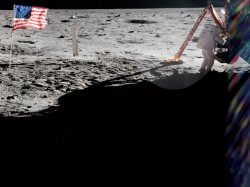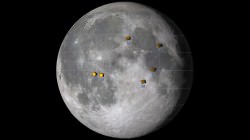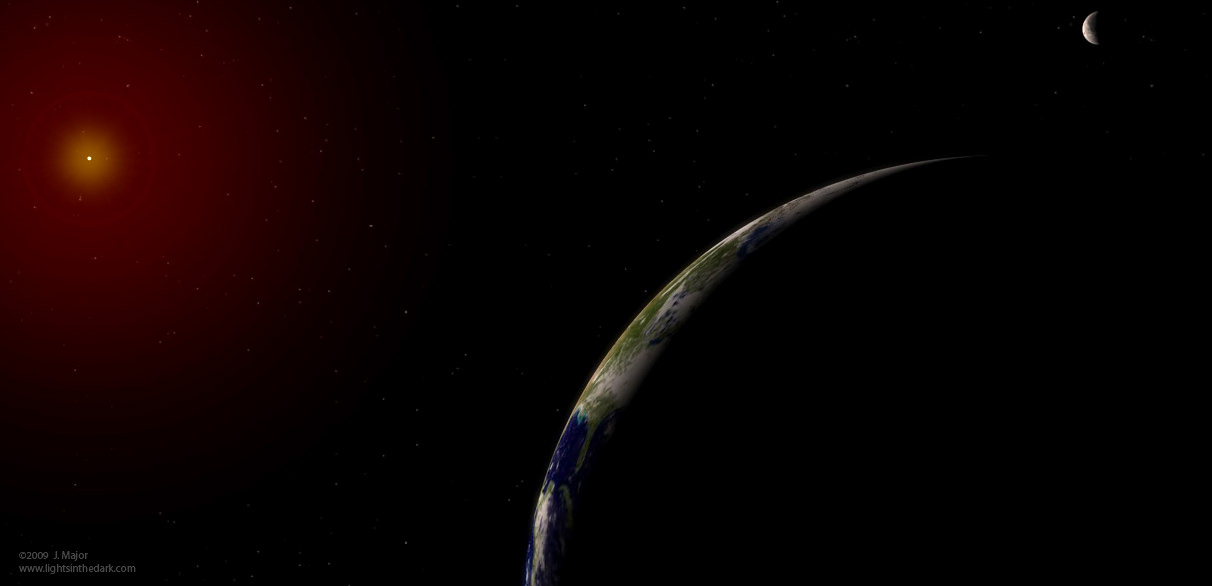There’s a conspiracy theory that astronauts never landed on the Moon. Is it all a conspiracy? Were the Moon landings faked? What is the evidence that we actually went to the Moon?
Apparently, there’s an organization called “NASA”, who’s done a remarkable job of sticking to their story. They say Neil Armstrong and Buzz Aldrin landed on the Moon on July 20, 1969, and set foot on the surface 6 hours later.This same organization claims there were 5 additional missions which successfully landed on the Moon, and an alleged total of 12 people went for a walk there.
Can you imagine? According to them, they spent $24 billion, which is more than $150 billion in inflation adjusted dollars. Their so-called “Apollo” program allegedly employed 400,000 people, supported by more than 20,000 companies and research institutions. I say “alleged”, as some people choose to think the Moon landings were acts of cinematic chicanery.
More than 10 years ago, Fox popularized the Moon landing conspiracy with a show called “Did We Land On The Moon?”. They revealed several pieces of evidence about the hoax and cover-up citing incorrect shadows on the Moon, lack of background stars, and more. Each of the pieces of evidence they present is wrong and easily explained once you understand the underlying science.… Or at least, that’s what they would have us believe.
Phil Plait successfully brings a NASA supporting voice to this story, explaining how the evidence against moon landings is at best, fantasy and misunderstanding. A more cynical view might be to suggest it’s a deliberate manipulation created to maintain an anti-scientific narrative to foster ignorance, mistrust and uphold a larger political agenda. Do a little search for “Phil Plait moon landing” and you’ll see him present even-handed science over any one of the arguments. In fact, if you buy into that whole “evidence” idea, he appears to successfully tear apart the conspiracy arguments.
Some still, are not convinced, possibly including you. “NASA and Phil, they’re in cahoots. Phil’s a PhD astronomer, which means he studies space, one of the letters in NASA stands for SPACE, I think it’s the A.” Coincidence? I think not. There’s collusion going on there.
The main pillar of any conspiracy requires a few select people keeping a really, really, really big secret. Looking at the numbers, the select group required to successfully fabricate the appearance of hurling metal capsules containing humans at our orbiting neighbor and then retrieving them, additionally keep their story straight for at best 45 years, and never, ever slip up… is about 400,000 humans.

So, there are really two sides to this story, the NASA side which is… They went to the Moon. and everyone is telling the truth. OR, they never went to the Moon, and somehow 400,000 people have never, ever, ever, ever let it slip that they made a bunch of fake moon rocks, or the rockets shot up didn’t really go anywhere. It’s all a big ruse. The thought 400,000 people have managed to keep their mouths shut is definitely the more romantic perspective. Seeing people come together to screw with everyone, and then never blabbing. This truly is a triumph of the human spirit.
When something big does happen, like the Chelyabinsk meteor, we see the evidence everywhere – for example captured on Russian dashboard cameras. For the lunar landing, NASA suggests something similar. There are independent astronomers who tracked the rockets escape from Earth’s gravity, and are either providing unsolicited, nonpartisan unfunded support of the events, or they’re in on the whole thing. The Russians, who were in a race with the Americans to be the first to set foot on the Moon, allegedly tracked the missions in horror and disappointment.
NASA just keeps sticking to this story that they sent people to the moon. In fact, they just keep on producing more of their “evidence”. They recently published high resolution images of the surface of the Moon captured by their own Lunar Reconnaissance Orbiter. Adding a whole new generation of secret keepers, who now know the secret handshake and get participate in the rigging of Oscar nights.

They imaged all of the alleged Apollo landing sites, and they haven’t missed any detail. You can see the landers, rovers, and even the astronauts’ footsteps. The images show that all the flags planted are still standing, except Apollo 11, which was blown over by the exhaust from the ascent engine. Or alleged exhaust from an alleged ascent engine, if you’re still thinking 400,000 people are continuing to punk the triumphs of mankind. Some might suggest that a big paycheck was sent on over to China and Japan, to have them verify the landing sites by photographing them with their own spacecraft.
According to NASA the astronauts placed retro-reflectors during their missions which reflect light directly back to Earth. Apparently these can be used this to calculate the distance to the Moon with 1 cm accuracy. So, if you want to confirm that humans went to the Moon for yourself, you could just point a high-power laser at the landing sites. Sure, there are many large independent institutions which have verified the existence of these retro-reflectors, but who knows, maybe they’re some how pawns of our silent and vigilant 400,000 co-conspirators.
What do you think? Make up a conspiracy theory for your favorite triumph of human innovation and exploration! Post it in the comments below.



